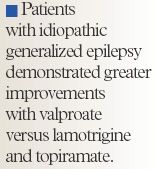- Safety & Recalls
- Regulatory Updates
- Drug Coverage
- COPD
- Cardiovascular
- Obstetrics-Gynecology & Women's Health
- Ophthalmology
- Clinical Pharmacology
- Pediatrics
- Urology
- Pharmacy
- Idiopathic Pulmonary Fibrosis
- Diabetes and Endocrinology
- Allergy, Immunology, and ENT
- Musculoskeletal/Rheumatology
- Respiratory
- Psychiatry and Behavioral Health
- Dermatology
- Oncology
Lamotrigine, valproate emerge as superior epilepsy treatment options as assessed in SANAD trial
The results of the Standard and New Antiepileptic Drugs (SANAD) trial, an unblinded, randomized, controlled, 2-arm study comparing the efficacy of various epilepsy drugs showed that for treatment of patients with partial seizures, lamotrigine demonstrated superior efficacy.

Key Points
The results of the Standard and New Antiepileptic Drugs (SANAD) trial, an unblinded, randomized, controlled, 2-arm study comparing the efficacy of various epilepsy drugs were recently published in the journal Lancet.

ARM A
All patients had a history of ≥2 clinically certain epileptic seizures in the previous year and were newly diagnosed, had failed previous treatments (different from those included in the randomization), or had entered remission from seizures but experienced relapse after treatment was stopped.
The primary end points were time to treatment failure and time to 1-year remission.
In terms of time to treatment failure, lamotrigine demonstrated superior efficacy compared with carbamazepine (HR=0.78; 95% CI, 0.63–0.97), gabapentin (HR=0.65; 95% CI, 0.52–0.80), and topiramate (HR=0.64; 95% CI, 0.52–0.79). There was a nonsignificant advantage with lamotrigine versus oxcarbazepine (HR=1.5; 95% CI, 0.86–1.54).
For 12-month remission, carbamazepine demonstrated superiority over gabapentin (HR=0.75; 95% CI, 0.63–0.90), but the drug was not associated with significant advantages compared with lamotrigine, topiramate, or oxcarbazepine.
A per-protocol analysis assessed the proportion of patients achieving a 12-month remission. At 2 and 4 years, the differences (95% CI) between lamotrigine and carbamazepine were 0 (–8 to 7) and 5 (–3 to 12), respectively, suggesting noninferiority of lamotrigine compared with carbamazepine.
ARM B
Arm B included 716 patients with generalized and unclassifiable epilepsy and compared long-term outcomes with the use of valproate (considered standard therapy for all enrolled patients), lamotrigine, and topiramate.
All patients had a history of ≥2 clinically certain unprovoked epileptic seizures in the previous year. Patients were newly diagnosed, had failed treatment with other drug therapy, or had entered remission from seizures but experienced relapse after treatment was stopped.
The primary end points were time to treatment failure and time to 1-year remission. A treatment goal for the study was to manage seizures with a minimum efficacious dose, allowing for dose increments if the number of seizures continued to increase.
The results demonstrated that, for time to treatment failure, valproate was superior to topiramate (HR=1.57; 95% CI, 1.19–2.08), but there was no significant difference between valproate and lamotrigine (HR=1.25; 95% CI, 0.94–1.68). Patients with idiopathic generalized epilepsy demonstrated greater improvements with valproate versus lamotrigine (HR=1.55; 95% CI, 1.07–2.24) and versus topiramate (HR=1.89; 95% CI, 1.32–2.70). For 12-month remission, valproate was superior to lamotrigine (HR=0.76; 95% CI, 0.62–0.94) and the drug also yielded the best results among patients with idiopathic generalized epilepsy compared with lamotrigine and topiramate (HR=0.68; 95% CI, 0.53–0.89). There was no significant difference between valproate and topiramate in the overall 12-month remission analysis or among patients with idiopathic generalized epilepsy.
In a related editorial, Jacqueline A French, MD, stated that the SANAD trial effectively coincides with the large volume of new antiepileptic therapies that have become available over the last few decades. Dr French stressed the importance of considering adverse events and individual patient characteristics when determining optimal epilepsy treatment and stated that: "Lamotrigine is the drug of first choice in patients with partial seizures, and valproate for patients with generalized or unclassified seizures in the absence of factors that would lead to an alternative choice."
SOURCES
Marson AG, Al-Kharusi AM, Alwaidh M, et al; on behalf of the SANAD Study group. The SANAD study of effectiveness of carbamazepine, gabapentin, lamotrigine, oxcarbazepine, or topiramate for treatment of partial epilepsy: An unblinded randomised controlled trial. Lancet. 2007;369:1000–1015.
Marson AG, Al-Kharusi AM, Alwaidh M, et al; on behalf of the SANAD Study group. The SANAD study of effectiveness of valproate, lamotrigine, or topiramate for generalised and unclassifiable epilepsy: An unblinded randomised controlled trial. Lancet. 2007;369:1016–1026.
French JA. First-choice drug for newly diagnosed epilepsy [editorial]. Lancet. 2007;369:970-971.
Employers Face Barriers With Adopting Biosimilars
March 1st 2022Despite the promise of savings billions of dollars in the United States, adoption of biosimilars has been slow. A roundtable discussion among employers highlighted some of the barriers, including formulary design and drug pricing and rebates.
